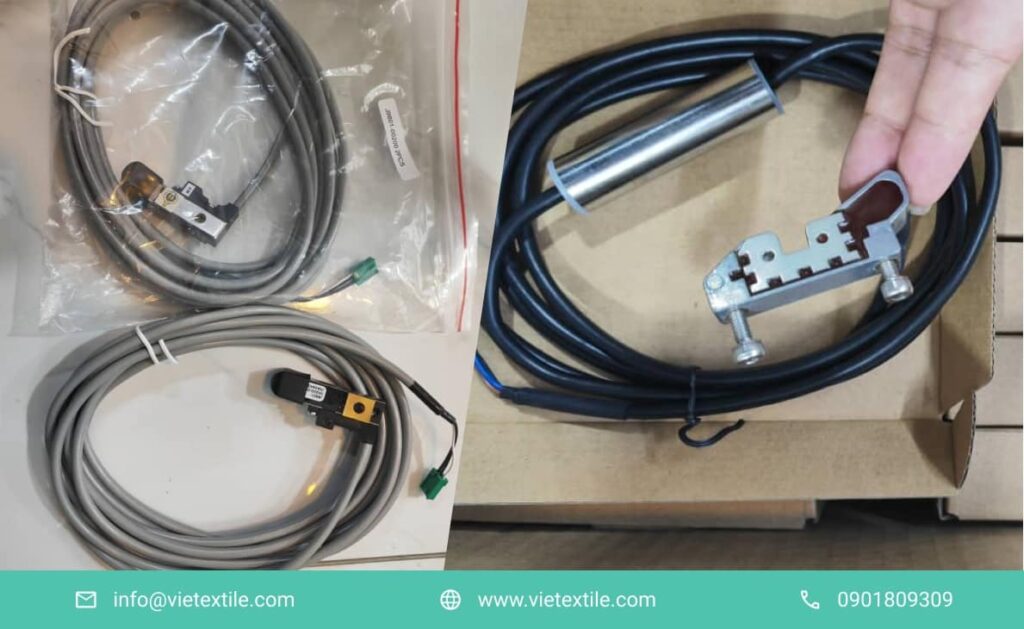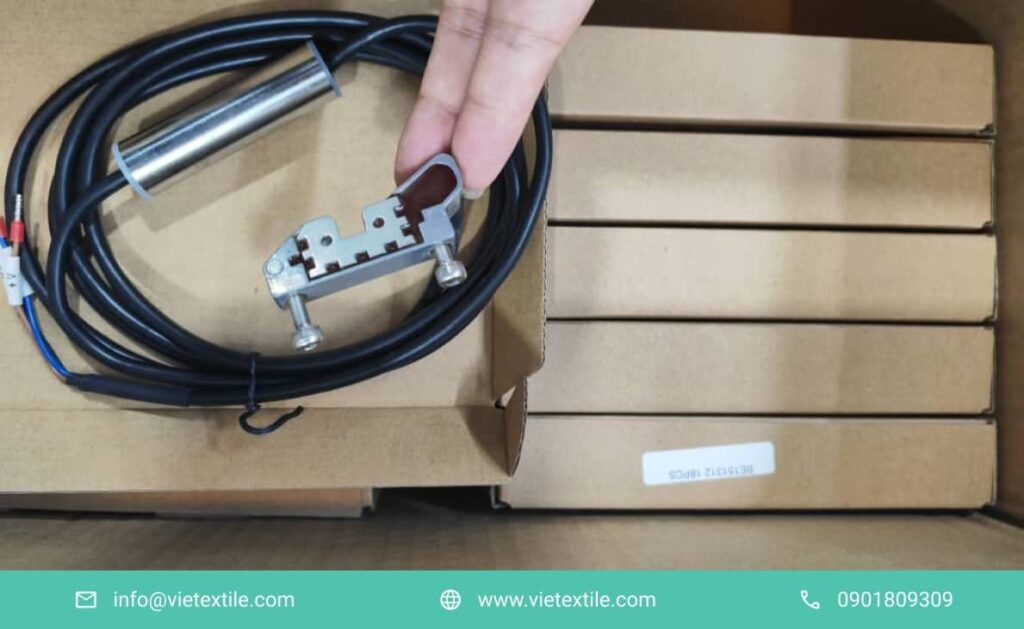In high-speed weaving, warp yarn breakage is an inevitable incident. If this fault is not immediately detected and addressed, the loom will continue weaving without the weft yarn, causing severe weaving defects (Mispick, Crack) that span multiple picks, damaging the finished fabric, and reducing product value.
The Weft Stop Motion system (The mechanism for stopping the machine upon weft breakage) was developed to solve this problem. This is a core safety component that determines the output quality of the loom. Maintenance and Procuring Weft Stop Motion Components are vital factors in ensuring instantaneous reaction, minimizing damage, and maintaining stable operational efficiency. This article will delve into the operating principle, the types of faults that arise, and the strategy for managing replacement components.
Modern looms operate at speeds up to thousands of Picks Per Minute (PPM). A weft breakage fault lasting only a few seconds can create a flawed fabric segment several meters long. The main function of the Weft Stop Motion is to detect the absence of the weft yarn as it crosses the fabric width (or immediately after it is cut). Upon detecting an error, the system sends a signal to the central controller to activate the electromagnetic brake (Brake) and stop the machine immediately.
The precision and reaction speed of the Weft Stop Motion entirely depend on the sensitivity of the sensors (Sensor) and the quality of the related electronic components. Substandard components can lead to two serious types of errors: “False Stop” (causing time waste) and “Missed Stop” (causing severe fabric damage).
To optimize efficiency and quality, textile factories need to understand the structure, operating mechanism, and know the correct method for Procuring Weft Stop Motion Components, suitable for each type of loom (Airjet, Waterjet, Rapier) and the type of yarn being woven. We will analyze these issues in detail.

1. Structure and Operating Principle of the Weft Stop Motion
Nội dung tóm tắt
ToggleWeft Stop Motion is an integrated system consisting of synchronized electro-mechanical components.
1.1. Core Components of the System
- Weft Sensor/Detector: This is the heart of the system, usually an optical sensor (Photo Sensor) or a capacitive/piezoelectric sensor. Its function is to detect the presence of the weft yarn at one or more specific positions across the fabric width.
- Amplifier/Controller: Receives the extremely small signal from the sensor, amplifies it, and compares it with the reference signal (Reference Signal) within the set timing window (Timing).
- Stopping Mechanism (Brake & Clutch): Upon detecting a fault signal, the controller activates the brake to stop the machine in the shortest time possible, typically less than one weaving cycle.
1.2. In-Depth Operating Principle (Timing)
The Weft Stop Motion system does not operate continuously but is activated within a specific time window (Window Time), typically measured by the main shaft’s rotational angle (Crank Angle).
- Weft Detection Position: The weft yarn is checked at one or more positions, for example: 30% (start), 50% (middle), and 90% (end) of the fabric width.
- Fault Handling Process:
- The weft yarn is inserted.
- The sensor detects the yarn and sends a “OK” signal to the processor.
- If no “OK” signal is received within the allowed time window, the processor confirms a weft break.
- The electromagnetic brake (Brake Solenoid) is activated to stop the machine immediately.
- The machine stops at a safe position (usually 90 or 180 degrees) for the technician to easily handle the fault.
2. Core Effects in Reducing Finished Fabric Damage
Weft Stop Motion plays a critical role in protecting finished fabric quality from serious, especially repetitive, defects.
2.1. Preventing Extended Mispick Defects (Missing Weft Yarn)
A Mispick fault occurs when the machine fails to stop immediately after a weft break.
- Damage: As the machine continues to run, it creates a gap without weft yarn, then inserts a new yarn in the next cycle. This fault creates a “crack” (Crack) or a different colored horizontal stripe (Barre) on the fabric, degrading the finished fabric value to Grade B, or even Grade C.
- Effect: Weft Stop Motion ensures the machine stops immediately within the weaving cycle where the fault occurs, limiting the Mispick defect to just one pick, making it easier for the technician to handle the fault and perform pick removal.
2.2. Controlling Tension Marks and Loose Yarn Loops
Weft tension is crucial. When a yarn breaks, the remaining yarns can become unevenly tense or loose.
- Damage: If the machine does not stop quickly, tension fluctuation can cause a horizontal stripe effect (Barre) or deform the weaving structure around the break point.
- Effect: Instantaneous machine stoppage helps fix the position of the remaining warp and weft yarns, minimizing mechanical deformation of the fabric structure before the fault is addressed.
2.3. Minimizing Mechanical Impact During Fault Handling
When the machine stops promptly, the fault handling process (cleaning broken yarn, re-inserting yarn) takes place more easily. Benefit: Reduces worker manipulation time and avoids auxiliary damage to other components like the Reed or Heddle due to tangled broken yarn. Advice: Procuring Weft Stop Motion Components helps the system stop the machine smoothly, without mechanical shock, protecting the lifespan of the brake and motor.
3. Common Types of Weft Stop Motion and Replacement Components

The selection and Procuring Weft Stop Motion Components must be based on the technology and the type of loom being used.
3.1. Optical Weft Stop Motion (Photo Sensor)
Common on Airjet and Rapier looms. The system uses a light beam and a receiver to detect the yarn.
Principle: The weft yarn passing through cuts the light beam, creating a signal change at the receiver. If there is no change, the machine reports an error.
Components to Procure:
- Transmitter/Receiver: Sensors must have high sensitivity and good resistance to dust/vibration.
- Signal Cable: Cables must withstand heat and friction, ensuring the signal is not disturbed. Wear Fault: The sensor surface accumulates dust or is scratched, leading to a “False Stop” due to a weak signal. It is necessary to focus on Procuring Weft Stop Motion Components for replacement and adjusting the angle.
3.2. Capacitive/Piezoelectric Weft Stop Motion
Often used in applications for weaving metal or conductive yarns.
- Principle: Detects changes in capacitance or pressure as the weft yarn passes through.
- Components to Procure: The piezoelectric sensor and the pre-amplifier (Pre-Amplifier) must have high electromagnetic noise filtering capability.
3.3. Hydraulic Weft Stop Motion (Waterjet Detectors)
Specific to Waterjet looms. Typically optical or mechanical sensors sensitive to the presence of the water stream carrying the yarn.
- Components to Procure: The sensor must be protected by a waterproof casing and withstand humid, corrosive environments. Procuring Weft Stop Motion Components for Waterjet looms requires corrosion-resistant materials.
4. Diagnosing Common Faults Due to Worn Weft Stop Motion Components
The wear and tear of the Weft Stop Motion system causes two main types of faults: False Stop and Missed Stop.
4.1. False Stop Fault – Causing Productivity Waste
This fault occurs when the machine stops but the weft yarn was actually inserted successfully. Main Causes:
- Dust Accumulation on Sensor: Yarn dust adheres to the optical sensor surface, attenuating the signal strength.
- Overly High Sensitivity Setting: The system is set too sensitively, making it easily affected by vibration or electromagnetic noise.
- Damaged Signal Cable: The cable is cracked, exposed, or has poor contact, causing sudden signal loss/noise. Remedy: Regular cleaning. If the fault persists, it is necessary to focus on Procuring Weft Stop Motion Components.
4.2. Missed Stop Fault – Causing Severe Fabric Damage
This fault occurs when the weft yarn breaks but the machine does not stop, creating an extended Mispick defect. Main Causes:
- Completely Damaged Sensor: The electronic circuit or the transmitter/receiver of the sensor is burned/damaged.
- Faulty Processor (Amplifier): The signal processing chip no longer functions accurately.
- Incorrect Stopping Timing: The time window for checking the yarn does not match the time the yarn passes through. Remedy: This is a serious fault, requiring immediate replacement. It is necessary to focus on Procuring Weft Stop Motion Components.
5. Strategy for Management and Procuring Weft Stop Motion Components

To optimize weaving efficiency, a smart procurement and maintenance strategy is needed.
5.1. Total Cost of Ownership (TCO) Analysis
The initial purchase price should not be the sole comparison point.
- OEM Components: Ensure high precision and long lifespan (typically 20,000 – 30,000 hours), minimizing False Stop and Missed Stop faults. TCO is lower due to fewer sudden failures and less fabric defects.
- Aftermarket Components: Can be 50% cheaper, but are prone to interference and failure in vibrating environments, leading to increased machine downtime costs, fault handling costs, and rejected fabric costs. Conclusion: For Critical (Grade A) Weft Stop Motion Components, prioritize the method of Procuring Weft Stop Motion Components.
5.2. Essential Spare Parts Stocking (Safety Stock)
Stocking easily damaged components is necessary to avoid component waiting time.
- Products to Stock: Backup optical sensors, signal cables, and related brake relays/solenoids.
- Priority: Stock sensors for the highest-speed loom models (e.g., Toyota JAT710, Tsudakoma ZAX9100) because these machines pose the greatest risk of creating fabric defects.
5.3. Alignment Procedure After Replacement
After Procuring Weft Stop Motion Components and replacing them, alignment is mandatory.
- Crank Angle Alignment: Ensure the sensor is activated and checks the yarn at the exact main shaft crank angle specified by the loom manufacturer. A 1-degree deviation can cause a fault.
- Sensitivity Adjustment: Use a measuring device (Oscilloscope) to check the signal amplitude. Sensitivity must be set at the optimal level: high enough to detect thin yarns, but low enough to resist noise and vibration.
6. Technical Factors When Procuring Weft Stop Motion Components by Loom Brand
Each loom brand has different technical requirements for Weft Stop Motion Components.
6.1. Toyota Airjet Looms (JAT Series)
- Requirement: Components must be compatible with Toyota’s high-speed signal processing system. The sensor must be effective against fly dust, as the Airjet environment is often dry and dusty.
- Focus when Procuring: The durability of the sensor casing and the quality of the connector to withstand continuous vibration.
6.2. Tsudakoma Waterjet Looms (ZW Series)
- Requirement: Components must be completely waterproof and corrosion-resistant. The sensor must be protected by a casing with a high IP (Ingress Protection) rating.
- Focus when Procuring: The material of the protective casing and signal cable must withstand humid environments and chemical vapors. Procuring Weft Stop Motion Components for Waterjet looms requires special attention to corrosion resistance.
6.3. Rapier Looms (Dornier, Picanol)
- Requirement: High precision in timing due to the more complex weft insertion mechanism. The sensor needs to be installed at multiple points to check the entire length of the weft yarn.
- Focus when Procuring: Sensitivity and the ability to transmit accurate signals over long distances (especially for wide-width looms).
7. VieTextile: The Comprehensive Solution for Procuring Weft Stop Motion Components
VieTextile is a trusted partner providing genuine Weft Stop Motion solutions and specialized technical services.
7.1. Supplying OEM Components Guaranteeing Reaction Speed
We provide OEM sensor components and signal amplifiers, ensuring a reaction speed of under 1 ms – a key factor for the machine to stop promptly at weaving speeds over 1500 PPM.
- Quality Control: Every Weft Stop Motion Component is tested for sensitivity and noise immunity before reaching the customer.
7.2. Specialized Technical Alignment Support
Replacing the Weft Stop Motion requires specialized knowledge of weaving angles and electronics. VieTextile’s technical team assists with:
- Timing Setup: Adjusting the main shaft crank angle so the sensor checks the yarn at the correct moment.
- Noise Handling: Diagnosing and eliminating electromagnetic interference (EMI) sources that cause False Stop faults.
7.3. Diversifying Parts Selection
VieTextile provides a full range of Weft Stop Motion Components for popular loom brands (Toyota, Tsudakoma, Picanol, Dornier, Sulzer), making it easy for factories to focus on Procuring Weft Stop Motion Components suitable for each specific Model.
8. Frequently Asked Questions about Procuring Weft Stop Motion Components (FAQ)
This section addresses specialized questions related to the Weft Stop Motion system and component procurement.
8.1. How do I know if the Weft Stop Motion sensor needs to be replaced? Answer: The sensor needs replacement when: 1) The frequency of False Stop or Missed Stop faults suddenly increases, which is not caused by dust or incorrect alignment. 2) After measurement, the sensor’s Signal Amplitude drops below the safe threshold, despite being thoroughly cleaned.
8.2. How does the choice made when Procuring Weft Stop Motion Components directly affect the fabric? Answer: The choice of poor-quality items when Procuring Weft Stop Motion Components results in slow reaction speed (signal delay), causing the machine to stop 10 ms later. This delay is enough to create an extended Mispick fault, leading to a Crack defect on the fabric or a serious horizontal stripe defect.
8.3. Can a faulty optical sensor be repaired? Answer: Most modern optical sensors are monolithic components. Repair is often ineffective and does not guarantee sensitivity, especially for high-speed sensors. The safest solution is Procuring Weft Stop Motion Components.
8.4. How should a False Stop fault caused by the Weft Stop Motion be handled? Answer: First, clean the sensor and check the signal cable. If the fault persists, try slightly reducing the Sensitivity. If it still cannot be resolved, the fault may lie in the Amplifier or the sensor itself has suffered permanent sensitivity degradation and needs replacement.
8.5. What is VieTextile’s commitment when Procuring Weft Stop Motion Components? Answer: We commit to supplying OEM or OEM-equivalent components, guaranteeing precise tolerance and reaction speed according to the machine manufacturer’s standards, helping you optimize fabric quality and minimize machine downtime.
Weft Stop Motion is the quality shield for finished fabric. Don’t let worn components harm your profit. Contact VieTextile immediately for specialized consultation on the Weft Stop Motion system, fault diagnosis, and to ensure the Procuring Weft Stop Motion Components, guaranteeing superior reliability and performance for your loom.
Contact Information:
Hotline: 0901 809 309
Email: info@vietextile.com
Website: https://vietextile.com










